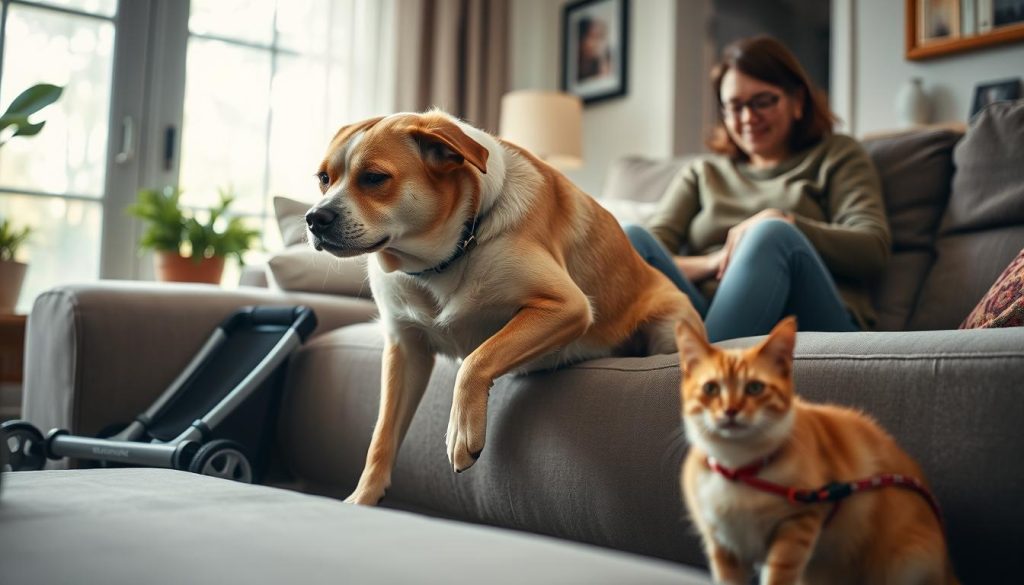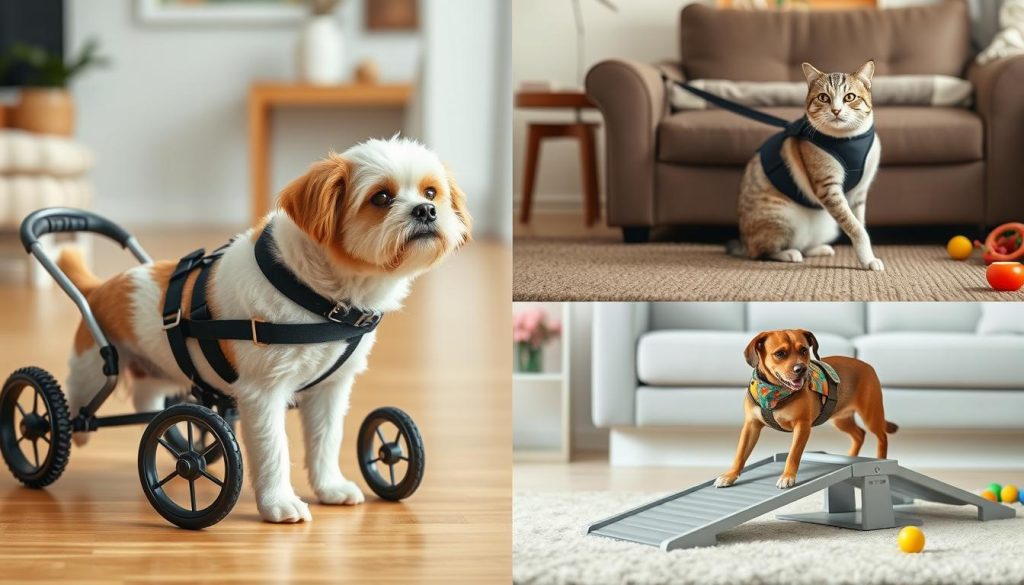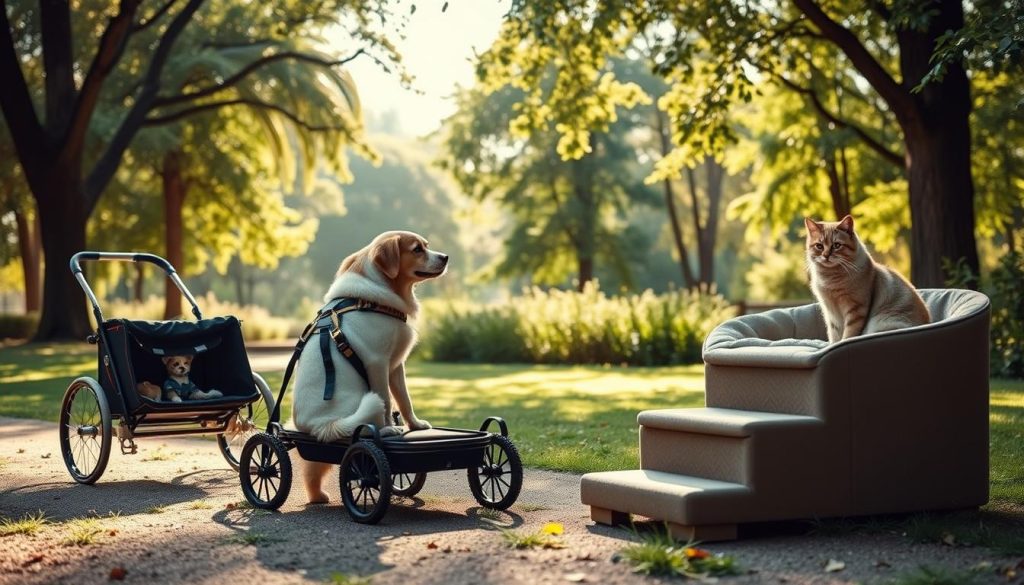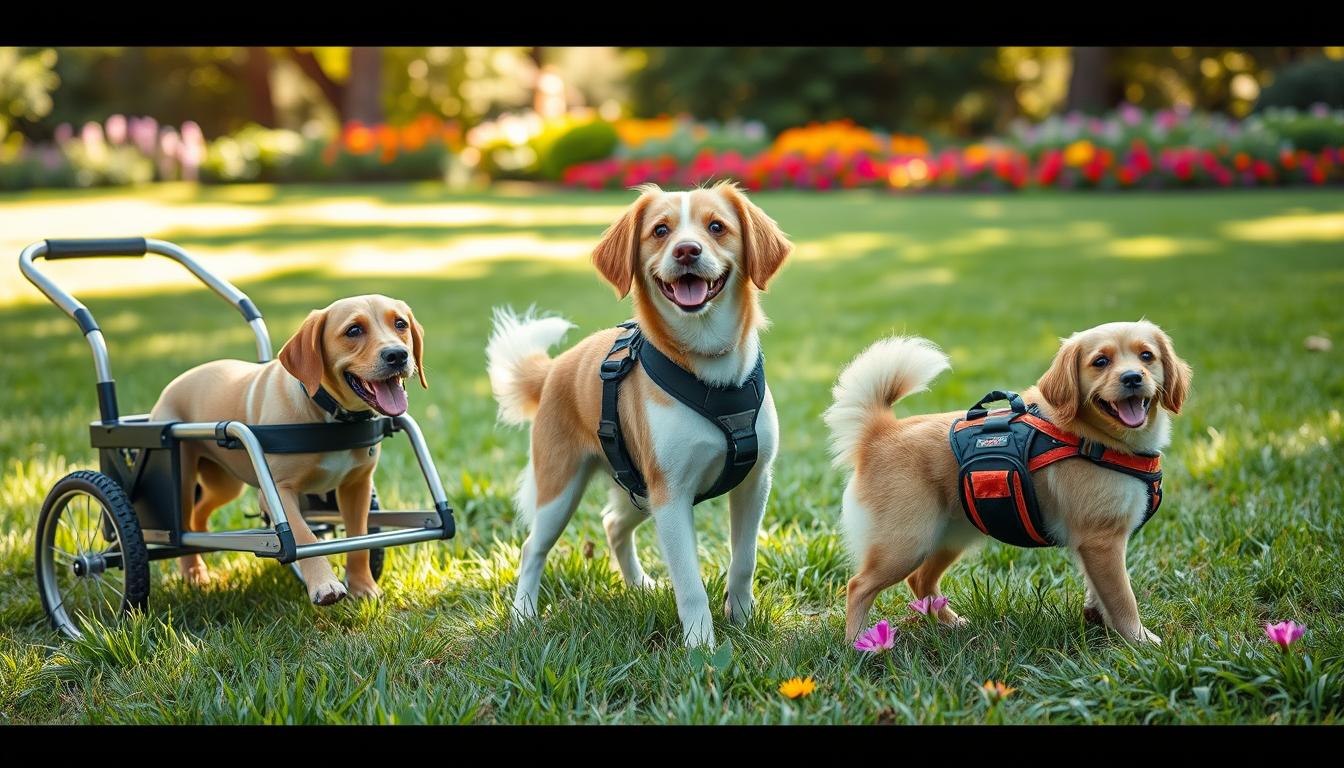As a pet owner, seeing our beloved companions struggle with mobility is heartbreaking. It could be due to age, injury, or a medical condition. Luckily, there are many pet mobility aids to help them move better and stay active. In this article, I’ll explain the common causes of reduced mobility in pets.
I’ll also cover the different types of mobility solutions for pets. Plus, I’ll show you how to pick the right assistive devices for pets. This will help improve pet mobility and boost their overall health.
Understanding Pet Mobility Issues
Keeping our pets mobile and independent is key to their happiness. Many things can make pets less mobile, affecting their life quality. It’s vital for pet owners to know what causes these issues and how to spot when their pet needs help.
Common Causes of Reduced Mobility
Age plays a big role in pet mobility problems. Older pets often face joint issues, arthritis, or other age-related conditions. Injuries, like torn ligaments or broken bones, can also reduce mobility. Plus, health issues like neurological problems or obesity can make it hard for pets to move easily.
Signs Your Pet May Need Assistance
Spotting signs of mobility issues in pets is crucial for their support. Look out for these signs:
- Difficulty standing up or lying down
- Reluctance to engage in physical activity or play
- Favoring one leg or limping
- Reduced agility and balance
- Muscle atrophy or weakness
- Pain or discomfort during movement
If you see these signs in your pet, it’s time to talk to your vet. They can help find the cause and suggest ways to improve your pet’s mobility.

Types of Pet Mobility Aids
There are many ways to help pets move better. From harnesses and carts to slings and special devices, these tools can greatly improve a pet’s life. They are designed to meet different needs, helping pets with mobility issues.
Harnesses are a popular choice. They offer support and stability, letting pets walk, stand, or be carried easily. They fit various body types and mobility levels, making them great for dogs and cats.
Pet carts, or wheelchairs, are a big help for pets needing more support. These customizable devices let pets move around on their own, even with limited mobility. They’re especially useful for pets with weak hind legs or paralysis.
Slings and lifts are great for pets needing help with weight or getting in and out of cars. They support the pet’s body, making it easier for owners to help during daily tasks.
There are also specialized devices like leg braces, prosthetic limbs, and underwater treadmills. These advanced tools help pets with complex mobility issues, helping them live more active lives.
Choosing the right pet mobility aid is key. It should match your pet’s needs and provide the support and comfort they need. With the right device, your pet can enjoy a more active and happy life.
| Type of Pet Mobility Aid | Description | Suitable for |
|---|---|---|
| Harnesses | Specialized harnesses that provide support and stability for pets to walk, stand, or be carried | Dogs and cats with various mobility challenges |
| Pet Carts/Wheelchairs | Assistive devices that allow pets with hind-limb weakness or paralysis to regain independence and enjoy an active lifestyle | Pets with limited mobility in their hind legs |
| Slings and Lifts | Tools that gently support a pet’s body, making it easier for owners to assist them during daily activities | Pets that need help with weight-bearing or getting in and out of vehicles |
| Specialized Devices | Advanced solutions like leg braces, prosthetic limbs, and underwater treadmills that cater to pets with complex mobility challenges | Pets with unique mobility needs |

Choosing the Right Aid for Your Pet
Choosing the right mobility aid for your pet is key to their comfort and health. There are important things to think about when picking a mobility aid for your pet. By looking at your pet’s needs, you can find the best aid for them.
Factors to Consider
To pick the right aid for your pet, consider these factors:
- Your pet’s size and weight: The aid should fit your pet well and offer stability.
- Your pet’s mobility challenges: Knowing their specific issues helps find the best aid.
- Your pet’s activity level: Choose an aid that lets them move safely and comfortably.
- Your pet’s comfort and ease of use: The aid should be comfy for your pet and easy for you to use.
| Mobility Aid | Suitable for | Benefits |
|---|---|---|
| Wheelchair | Pets with paralysis or limited leg function | Provides full support and mobility for pets with significant mobility challenges |
| Harness | Pets with arthritis, muscle weakness, or joint pain | Offers support and stability, allowing pets to remain active and independent |
| Slings | Pets recovering from injury or surgery | Helps pets regain strength and mobility during the rehabilitation process |

By thinking about these factors and looking at different aids, you can find the best one for your pet. This will help them stay independent and live a better life.
Pet Mobility Aids: A Game-Changer for Comfort
Caring for a pet can be rewarding but also challenging, especially when they have mobility issues. Pet mobility aids have changed the game, improving their quality of life. These devices help pets enjoy activities they love.
Pet mobility aids help reduce pain and discomfort. They support pets with injuries, chronic conditions, or aging. This support reduces joint pressure, improves stability, and lessens discomfort. Pets can move more easily and stay active.
The impact of mobility aids on pets’ lives is huge. They regain independence and can move around easily. This makes them happier, less stressed, and more content.
Using mobility aids for pets is truly transformative. These aids help pets keep up with their routines and enjoy playtime. Seeing the positive impact on our pets’ comfort and happiness is heartwarming.
| Mobility Aid | Impact on Comfort | Improvement in Quality of Life |
|---|---|---|
| Wheelchairs | Reduces pressure on joints, enables mobility | Restores independence, allows participation in activities |
| Harnesses | Provides support and stability, relieves strain | Enhances confidence, enables exploration and play |
| Ramps | Eases access to elevated surfaces, minimizes stress | Preserves access to favorite spots, maintains routines |
Introducing Aids to Your Pet
Introducing a mobility aid to your pet needs care. But, with the right steps, it can be a positive experience. Start slow, be patient, and keep your pet comfortable and secure.
Tips for a Smooth Transition
Let your pet explore the new aid at their own speed. Place it where they spend time and let them sniff it. Give treats and praise when they show interest. This makes them link the aid to good things.
Begin using the aid for short times first. As they get used to it, make the sessions longer. Use treats, affection, and praise to boost their confidence.
Every pet is different, so be ready to change your plan if needed. With patience, consistency, and creativity, your pet can get used to their new aid. They’ll soon enjoy the benefits it brings.

